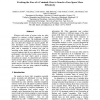Free Online Productivity Tools
i2Speak
i2Symbol
i2OCR
iTex2Img
iWeb2Print
iWeb2Shot
i2Type
iPdf2Split
iPdf2Merge
i2Bopomofo
i2Arabic
i2Style
i2Image
i2PDF
iLatex2Rtf
Sci2ools
BLISS
2007
IEEE
2007
IEEE
Evolving the Face of a Criminal: How to Search a Face Space More Effectively
Witnesses and victims of serious crime are often required to construct a facial composite, a visual likeness of a suspect’s face. The traditional method is for them to select individual facial features to build a face, but often these images are of poor quality. We have developed a new method whereby witnesses repeatedly select instances from an array of complete faces and a composite is evolved over time by searching a face model built using PCA. While past research suggests that the new approach is superior, performance is far from ideal. In the current research, face models are built which match a witness’s description of a target. It is found that such ‘tailored’ models promote better quality composites, presumably due to a more effective search, and also that smaller models may be even better. The work has implications for researchers who are using statistical modelling techniques for recognising faces.
| Added | 02 Jun 2010 |
| Updated | 02 Jun 2010 |
| Type | Conference |
| Year | 2007 |
| Where | BLISS |
| Authors | Charlie D. Frowd, Vicki Bruce, Carol Gannon, Mark Robinson, Colin Tredoux, Jo Park, Alex H. McIntyre, Peter J. B. Hancock |
Comments (0)

